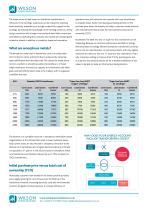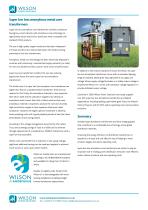
Catalog excerpts

Amorphous metal core technology: Transforming energy efficiency of power distribution networks Wilson Power Solutions Best Practice Series Dr Lore Grohmann of Wilson Power Solutions explains how super low loss amorphous distribution transformers can help improve the energy efficiency of small power distribution networks Despite the generally high operational efficiency of distribution transformers, a considerable loss of energy occurs due to the large numbers of distribution transformers installed across global distribution networks: It is commonly estimated around 3% of all electricity generated worldwide (˜25 GW) is wasted through transformer operating losses. According to a 2008 study by SEEDT (Strategies for development and diffusion of Energy-Efficient Distribution Transformers) around 4.6 million distribution transformers are installed in the EU. Their losses exceed 38 TWh/year - this is more than the entire amount of electricity consumed by Denmark (or 8.5% of the electricity consumed in the UK) and equates to 30 million tonnes of CO2. Improving transformer efficiency by reducing these unnecessary losses constitutes a simple and effective way of improving energy efficiency across distribution networks. How? Reducing transformer losses voltage of the transformer is exceeded. Hysteresis losses can be Two types of losses are inherent in the running of distribution metal), while eddy currents can be lowered by reducing lamination transformers: no-load losses that occur in the transformer cores due reduced by selecting low core losses material (such as amorphous to hysteresis and eddy current losses which are constant and present as soon as the transformer is energised and load losses that occur in the transformer’s electrical circuit due to resistive losses that are a function of loading conditions. The main no-load loss is core loss, which is associated with the timevarying nature of the magnetising force and results from hysteresis and eddy currents in the core materials. Core losses are dependent upon the excitation voltage and can increase sharply if the rated www.wilsonpowersolutions.co.uk Tel: +44 (0)113 271 7588 Email: info@wilsonpowersolutions.co.uk
Open the catalog to page 1
The major source of load losses for distribution transformers is operations have led customers who operate their own transformers I2R losses in the windings. Load losses can be reduced by selecting to evaluate losses. Rather than basing purchasing decision on the lower-resistivity materials (such as high conductivity copper) for the purchase price alone, the majority of today’s customers chose products windings, by reducing the total length of the winding conductor, and by with reduced losses that provide the most attractive total cost of using a conductor with a larger cross-sectional...
Open the catalog to page 2
Super low loss amorphous metal core transformers Super low loss amorphous core transformers combine conductors having low current density with amorphous core technology to significantly reduce load and no load losses when compared with standard CRGO products. The use of high quality copper conductors has been widespread in Europe and the US to reduce load losses with products being promoted as ‘low loss’ transformers. Amorphous metal core technology has been intensively deployed in countries with notoriously overstretched supply networks (i.e. India) for over two decades and has a proven...
Open the catalog to page 3All Power and Distribution Transformers catalogs and technical brochures
-
POWER TRANSFORMERS
2 Pages
-
Wilson Power Solutions
20 Pages
-
Distribution Transformers
2 Pages
-
Power Transformers
2 Pages
-
POWER DISTRIBUTION SOLUTIONS
20 Pages

















